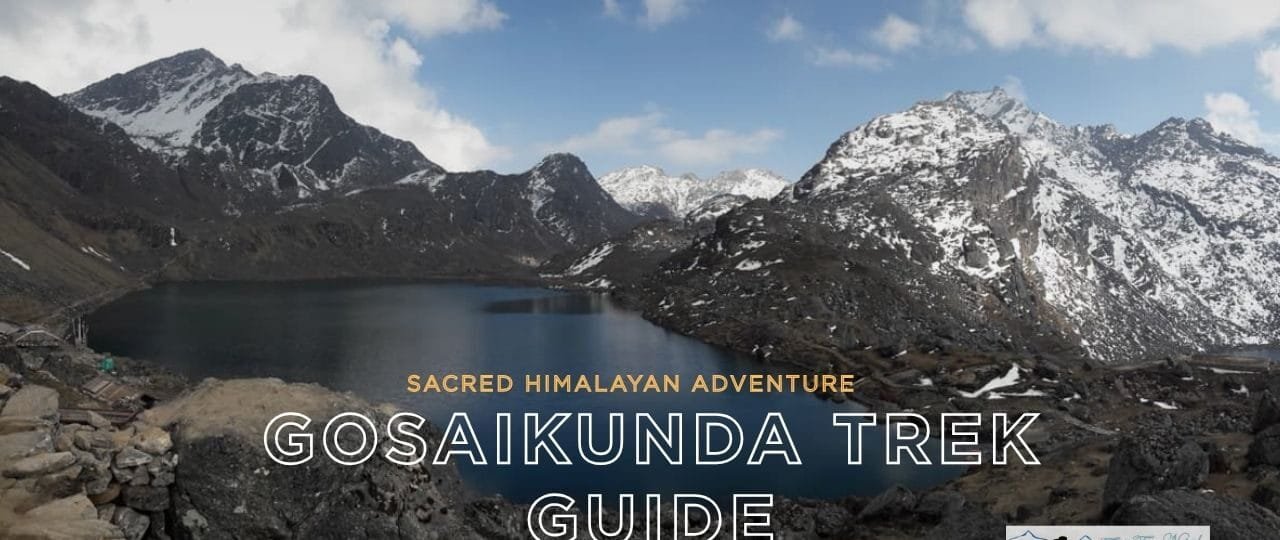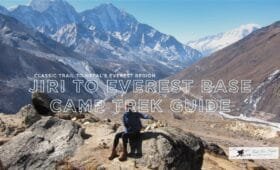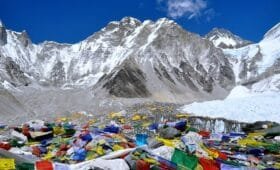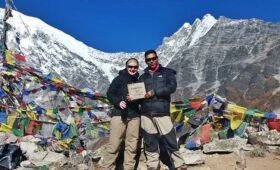The Gosaikunda Trek is a unique Himalayan journey that combines high-altitude lake exploration with rich cultural immersion. This moderate yet rewarding trail leads you into the heart of Langtang National Park, culminating at the sacred Gosaikunda Lake, renowned for its spiritual significance among Hindus and Buddhists alike. If you’re seeking an authentic trek that merges natural grandeur with cultural depth, the Gosaikunda Trek is a top-tier choice.
In this in-depth Gosaikunda Trek Guide article, we’ll delve into every facet of the trek: from the essential Gosaikunda Trek Itinerary to the typical Gosaikunda Trek Cost, permit requirements, route details, difficulty level, and best seasons to visit. You’ll also gain insight into how to seamlessly weave philanthropy into your trekking experience, collaborating with Volunteers Initiative Nepal (ViN) to support local communities along the way. Whether you’re a spiritual seeker, a mountain enthusiast, or a traveler eager to explore off-beat paths, the Gosaikunda Trek promises an incredible blend of nature, culture, and personal growth.
Introduction
1. Introduction: Why Choose the Gosaikunda Trek?
The Gosaikunda Trek appeals to a broad range of trekkers—from those wanting a moderate hiking challenge to pilgrims drawn to the sacred Gosaikunda Lake, perched at around 4,380 meters. Amid the Langtang Himal’s panoramic vistas, trekkers traverse rhododendron, oak, and bamboo forests, eventually transitioning into arid high-altitude landscapes. The sense of awe intensifies upon reaching Gosaikunda’s turquoise waters, believed to be formed by Lord Shiva’s trident.
Statistic: According to the Langtang National Park authorities, roughly 15,000 foreign trekkers visit this region annually, with a growing portion choosing the Gosaikunda route. Some arrive during Janai Purnima—an auspicious Hindu festival in August—when thousands of pilgrims dip in Gosaikunda’s chilly waters.
“I joined the Gosaikunda Trek for the lakes’ spiritual allure, yet the mountain scenery and local hospitality amazed me beyond words,” says Sarah, a 29-year-old Canadian trekker who completed the journey last spring.
History
2. Historical & Cultural Overview
The Gosaikunda region interweaves deep spiritual reverence with natural splendor. According to legend, Lord Shiva struck the mountains with his trident to form Gosaikunda, quenching his thirst after swallowing poison to save the universe. The lake is a pilgrimage site for Hindus, especially during Janai Purnima, and Buddhists who connect its waters to essential spiritual energies. The route’s local Tamang and Sherpa communities reflect a fusion of Buddhist traditions, Tibetan culture, and indigenous practices tied closely to the mountainous environment.
Modern trekking to Gosaikunda gained traction in the 1980s after more foreigners discovered the scenic wonder and intangible heritage. Today, the route remains less crowded than well-known circuits like Annapurna or Everest, offering a calmer, more meditative atmosphere. The Gosaikunda Trek Route meanders through Langtang National Park, established in 1976 to protect flora and fauna—ranging from red pandas to Himalayan black bears.
Trek Itinerary
3. Key Highlights of Gosaikunda Trek Itinerary
A standard Gosaikunda Trek Itinerary often ranges from 6–9 days, depending on side trips or pacing. Below is a common blueprint:
- Day 1: Kathmandu → Dhunche (~1,950m)
A ~6–7 hour bus ride from Kathmandu leads to Dhunche, a modest town and checkpoint for Langtang National Park permits. - Day 2: Dhunche → Thulo Syabru (~2,230m)
A scenic climb passing farmland and Tamang villages. You might choose an alternate path via Syabrubesi if you plan a more extended approach. - Day 3: Thulo Syabru → Sing Gompa (~3,330m)
Trails ascend pine and rhododendron forests. Sing Gompa, known as Chandanbari, is famous for its old monastery and small cheese factory. - Day 4: Sing Gompa → Laurebina (~3,900m)
The route grows steeper. Panoramic mountain vistas of Ganesh Himal and Langtang Lirung open up. Laurebina sets you up for the final approach to Gosaikunda. - Day 5: Laurebina → Gosaikunda Lake (~4,380m)
It is a relatively short but high-altitude trek day. Upon arrival, you’ll explore Gosaikunda Lake’s shoreline, circled by smaller lakes like Saraswati and Bhairav Kunda. - Day 6: Side Trips or Cross Laurebina Pass
Some itineraries push further across Laurebina Pass (~4,610m) to connect with Helambu. Others spend an extra day exploring lake spurs and returning to Sing Gompa or Cholangpati. - Day 7–8: Descent & Return
Retrace steps to Dhunche, often in 2 days, then bus back to Kathmandu.
The duration of the Gosaikunda Trek can be adjusted by adding side loops like Helambu or incorporating expansions around Tamang Heritage trails. Some prefer a minimal route (5–6 days) by skipping acclimatization or side hikes.
Trek Difficulty
4. Understanding the Gosaikunda Trek Difficulty
Generally considered moderate, the Gosaikunda Trek Difficulty arises from:
- Altitude: Reaching ~4,380m at Gosaikunda. Some might go above 4,600m crossing Laurebina Pass.
- Steep Climbs: Thulo Syabru to Sing Gompa or Sing Gompa to Laurebina. Test your stamina.
- Weather Variability: Sudden shifts, especially near Laurebina. Nights can be cold at high altitudes.
If you maintain a moderate fitness level (regular walking, some previous trekking experience), you can handle the daily 5–7-hour climbs. However, caution is vital around altitude sickness, so ascending gradually and hydrating correctly helps.
Trek Mapping
5. Mapping Your Route: A Look at the Gosaikunda Trek Map
A reliable Gosaikunda Trek Map highlights:
- Kathmandu to Dhunche: The main bus route, ~117 km, ~6–7 hours.
- Thulo Syabru: A crossroads for routes heading to the Langtang Valley or Gosaikunda.
- Sing Gompa (Chandanbari): Key stop with teahouses, a monastery, and a cheese production center.
- Laurebina: Panoramic ridge, the final staging point for Gosaikunda Lake.
- Gosaikunda: Main lake cluster; about a dozen smaller lakes surround it.
- Laurebina Pass: Some cross it to connect with Helambu, concluding near Kathmandu in ~4–5 more days.
Check for route updates, especially after monsoon or winter, as landslides or heavy snow might prompt a local guide to pick alternative trails or campsites.
Costing
6. How Much Does It Cost? Explaining the Gosaikunda Trek Cost
The Gosaikunda Trek Cost is lower than that of multi-week expeditions. Key factors:
- Permits:
- Langtang National Park Permit (~USD 30).
- TIMS Card (~USD 10–20).
- Transport:
- The Kathmandu to Dhunche bus ~ costs USD 5–8. Private jeeps, if shared among travelers, cost ~USD 100–120 each way.
- Accommodation & Food:
- Teahouses cost ~USD 3–8 per night.
- Daily meals ~USD 20–25 (dal bhat, noodles, mo: mo, plus teas).
- Guide / Porter (optional but recommended):
- Licensed guide ~USD 25–30/day, porters ~USD 15–25/day.
If you manage expenses responsibly, a 7–8–day itinerary typically costs ~USD 300–500. A Gosaikunda Trek Package from an agency might range ~ from USD 500–900, bundling lodging, some meals, guide wages, and transport logistics.
Booking
7. Booking the Right Gosaikunda Trek Package
Many agencies offer a Gosaikunda Trek Package that the following covers:
- Transport: Round-trip from Kathmandu to Dhunche or arrangements via Syabrubesi.
- Permits: Freed from local permit offices or confusion over fees.
- Guide & Porters: Handling route questions, altitude pacing, and cultural insights.
- Lodging & Some Meals: Typically included in mid-tier or premium packages.
Check the itinerary length, inclusion of side treks like Helambu, or possible expansions to the Tamang Heritage Trail. Read Gosaikunda Trek Reviews from prior clients for reliability indicators. Agencies with local expertise often craft better cultural experiences and ensure safer altitude transitions.
Trek Permits
8. Securing Gosaikunda Trek Permits
Gosaikunda Trek Permits revolve around:
- Langtang National Park Entry: ~USD 30 for foreigners (~NPR 1,500).
- TIMS Card: ~USD 10–20.
- Special Permissions: These are not typically required. If you merge Helambu or Tamang Heritage routes, confirm that no additional restricted permits are needed.
Carry your passport, visa, and 2–3 photos. The agency often handles these details if you have a Gosaikunda Trek Package. Keep permits with you, as rangers might check them near Dhunche or Sing Gompa.
Best Timing
9. Gosaikunda Trek Best Time: Seasons & Weather
The Gosaikunda Trek Weather can shift from warm foothills to cold, windy ridges near Laurebina. The recommended windows:
Monsoon (Jun–Aug): Daily rains in lower sections, leeches in forests, but Gosaikunda region might still be accessible. Janai Purnima sees a flood of pilgrims braving mud for a holy dip.
Autumn (Sept–Nov): Clear vistas, mild days (~15–20°C at lower altitudes), nights near freezing above 3,500m. Peak trekking popularity.
Spring (Mar-May): Rhododendron blooms, moderate temps, potential afternoon clouds. Crisp mornings for summits.
Winter (Dec–Feb): Sub-zero nights near Gosaikunda, possible heavy snow limiting passes. Suitable for solitude but requires sturdy gear.
Trek Guide
10. Hiring a Gosaikunda Trek Guide
While the route is moderately well-marked, hiring a Gosaikunda Trek Guide ensures:
- Local Insight: They detail cultural contexts, from Tamang villages to Gosaikunda’s legends.
- Altitude Management: Guides help pace and watch for sickness at around 4,000m.
- Logistics & Language: They handle teahouse reservations, communicate with locals, and pivot if weather demands route changes.
Expect to pay ~USD 25–30/day. Some travelers skip a guide to cut costs, but guides can transform a regular trek into a deeper cultural immersion. They also enhance safety when crossing Laurebina Pass in poor weather.
Tips
11. Preparation & Tips for Success
11.1 Physical Training
- Cardio: Running or brisk hill walks for ~4–6 weeks pre-trek.
- Leg Strength: Weighted squats, stair climbs, or lunges replicate daily ascents.
- Backpack Familiarity: Hike with ~8–10 kg to adapt shoulders and legs.
11.2 Gear & Clothing
- Layers: Thermal base, mid-layer fleece, down jacket, windproof outer layer.
- Footwear: Durable trekking boots, broken in well before arrival.
- Extras: Trekking poles, headlamp, personal medication kit, -10°C sleeping bag if trekking in winter.
11.3 Altitude Strategy
Gosaikunda Trek Altitude surpasses 4,380m at Gosaikunda Lake. Plan a gradual climb, possibly adding an extra acclimatization day near Sing Gompa or Laurebina. Drink 2–3 liters daily, avoid rushing, and watch for headache or dizziness.
12. Stories from the Trail: Testimonials & Inspiration
James’ Perspective
James, a 34-year-old hiker from Australia, found the Gosaikunda Trek “both scenic and spiritual.” He recalls a sunrise at Laurebina Pass unveiling the Langtang range. “Seeing Gosaikunda’s icy waters shimmer in dawn light was magical—plus chatting with pilgrims reminded me that trekking can be a personal and cultural pilgrimage at once.”
Local Impact
Laxmi, who runs a teahouse near Chandanbari, shares how moderate tourist flow boosts local cheesemaking, orchard expansions, and schooling materials for children. she says.
Trekkers help keep the route lively. We hope they also understand our culture—like how Gosaikunda’s water is believed to purify the mind and soul,
FAQs
13. Seven Most Frequently Asked Questions
Below are seven top queries about the Gosaikunda route:
How long is the Gosaikunda Trek Duration?
The standard itinerary typically takes 6–9 days, though some do it in 5 if they skip side explorations. Extending into Helambu can reach ~12 days.
What is the Gosaikunda Trek Difficulty rating?
Rated moderate. The maximum altitude is ~4,380m at Gosaikunda, with steep climbs near Laurebina: essential fitness and prior trekking experience help.
How much does the Gosaikunda Trek Cost?
Expect ~USD 300–500 for ~7–8 days (including permits, teahouse lodging, daily meals, and bus transport). A Gosaikunda Trek Package might cost ~USD 500–900.
Which Gosaikunda Trek Permits do I need?
Langtang National Park entry (~USD 30) and a TIMS card (~USD 10–20). No restricted permit is required for the standard route.
When is the Gosaikunda Trek Best Time?
Autumn (Sept–Nov) or spring (March) for mild weather, stable conditions, and minimal risk of heavy snow. Winter is possible but cold, and monsoons see daily rains in lower stretches.
Is a Gosaikunda Trek Guide necessary?
It is not mandated, but it is recommended if you desire cultural insights, help with altitude pacing or a safer route crossing near Laurebina Pass in winter.
What is the highest Gosaikunda Trek Elevation?
Gosaikunda Lake sits at ~4,380m. Laurebina Pass can surpass ~4,600m if you cross into Helambu.
Conclusion
From forested climbs around Thulo Syabru to the shimmering lakes at nearly 4,400m, the Gosaikunda Trek is a harmonious blend of spiritual exploration and mountain adventure. Each day reveals a shifting tapestry: farmland, thick pine glades, and eventually, the windy ridges above Laurebina. Arriving at Gosaikunda’s crystalline waters—sacred to Hindus and Buddhists—is a profound highlight, bridging nature’s magnificence with humanity’s timeless search for meaning.
Combine Trekking & Service with ViN
At Volunteers Initiative Nepal (ViN), we believe each trek can seed positive change for local communities:
- Volunteer: Dedicate a few days near Syabrubesi or Dhunche to teaching English, raising health awareness, or supporting environmental conservation.
- Donate: Uplift micro-infrastructure, equip schools, or sponsor child education in villages along the route.
- Intern: Integrate your academic or professional background to gather data or build sustainable solutions for rural livelihoods.
- Share: Urge fellow adventurers to unite their quest for scenic wonders with philanthropic goals—promoting mindful tourism that leaves intangible benefits behind.
Namaste, and may your footprints on the Gosaikunda Trek echo as more than personal triumph—let them ripple with empathy, forging deeper ties across cultures and fostering new opportunities for Himalayan communities.
Additional Tips
Additional Info & Practical Tips
We’ve covered the fundamentals, but extra nuances may refine your Gosaikunda Trek planning. Below, we address route expansions, gear specifics, volunteering synergy, and additional recommended steps to ensure a successful adventure.
1. Seasonal Weather & Variation
1.1 Autumn
- Crisp skies, mild days (~15°C at mid altitudes), nights near freezing above 3,500m. Jampacked teahouses in the prime weeks of October–November.
1.2 Spring
- Rhododendron forests in bloom, comfortable trekking. Potential afternoon showers or fog near passes. Evenings are still chilly at Lake-level altitudes.
1.3 Winter
- Diminished crowds and scenic clarity, but sub-zero nights near Gosaikunda. Some teahouses around Laurebina close. Plan gear carefully.
1.4 Monsoon
- Lush farmland, daily rainfall, leeches in lower forest. However, the Gosaikunda region receives fewer pilgrims except around Janai Purnima in July/August.
2. Variation: Helambu + Gosaikunda
2.1 Full Circuit
Some add Helambu to the Gosaikunda route, crossing Lauribina Pass (~4,610m) and descending into Helambu’s moderate altitudes. The combined trek can stretch to 12–14 days. This synergy merges vantage points with the cultural tapestry of Helambu’s Sherpa and Hyolmo communities.
3. Lodging & Cuisine
3.1 Teahouses
Gosaikunda Trek Accommodation typically revolves around teahouses from Dhunche to Laurebina. Once you cross the pass, if heading into Helambu, teahouses remain frequent but more rudimentary.
3.2 Food
Expect Nepali dal bhat, chow mein, Tibetan bread, mo: mo, and typical breakfast items like pancakes or chapati. At mid-altitudes, you might find local cheese made from yak or cow. Prices ascend with altitude, so budget accordingly.
4. Potential Hazards & Precautions
- Altitude Sickness: Respect your body’s signals, and rest if mild headaches or dizziness appear near Laurebina or Gosaikunda.
- Weather Shifts: Consult locals or guides about pass feasibility if storms or heavy snow.
- Crowding: Autumn crowds can make booking rooms at Sing Gompa or Laurebina difficult. Arrive early or pre-book with a package.
5. Volunteering with ViN
5.1 Pre-/Post-Trek
You can volunteer in synergy with ViN near Kathmandu or local districts, focusing on education, health, or the environment. Some choose short 2–3 day stints in villages on the route.
5.2 In-Route
Time constraints typically restrict central volunteering. However, distributing donated supplies (like stationery) to remote schools or participating in a day of cleanliness campaigns fosters direct community bonding.
6. Reflection & Future Opportunities
The route fosters a renewed sense of wonder, bridging pilgrims’ devotion and trekkers’ thirst for Himalayan beauty. Many find themselves returning to discover more of Langtang or Helambu or to deepen philanthropic ties. Sharing these experiences with friends or social media networks encourages responsible tourism that respects local culture and environment.




